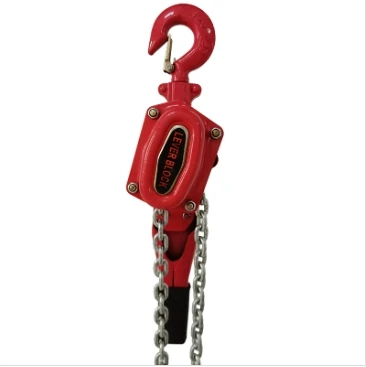


Understanding the Lever Block A Vital Tool in Mechanical Engineering
The lever block, often referred to as a chain block or hoist, is an essential tool widely used in various industries for lifting and moving heavy loads. This mechanical device employs the principles of leverage to amplify the force exerted by the user, making heavy lifting significantly easier and safer. In this article, we will explore the basic components, functions, and applications of the lever block, as well as its importance in modern mechanical engineering.
Basic Components and Functionality
A typical lever block consists of several key components a pull chain, a hook for attaching the load, a gear system, and a lifting chain. The core mechanics of a lever block rely on a simple yet effective principle through the application of a small force over a distance via the pull chain, a larger force can lift a heavier load over a shorter distance.
The process begins when the user pulls the lever or chain, which engages the internal gear mechanism. This mechanism amplifies the force, allowing the lifting chain attached to the hook to rise. The design enables the user to lift loads that would otherwise be impossible to move manually. The gear ratio is a critical factor; a higher ratio means that more effort is required on the pulling side, but it allows for greater weight to be lifted.
Versatility Across Industries
Lever blocks are not limited to industrial settings; they find applications in construction, shipping, manufacturing, and even home use. In construction sites, for instance, lever blocks are used to hoist beams, scaffolding, and heavy machinery components into place. Their ability to handle substantial weights makes them invaluable for safety and efficiency, preventing injuries that could arise from manual handling of heavy objects.

In manufacturing, lever blocks streamline the assembly process. They enable workers to position heavy components precisely without excessive strain. This not only increases productivity but also enhances safety standards in factories.
Shipping and logistics also benefit from the use of lever blocks. Heavy cargo can be loaded and unloaded more efficiently, reducing the time taken for each operation. This efficiency translates to cost savings for companies and faster delivery times for customers.
Importance in Safety
One of the most significant advantages of lever blocks is their contribution to workplace safety. Manual lifting of heavy loads poses a considerable risk of injury, including strains, sprains, and other musculoskeletal disorders. By using a lever block, workers can avoid excessive physical strain, significantly reducing the likelihood of accidents. Additionally, most lever blocks come equipped with safety features such as overload protection to prevent lifting beyond their specified capacity, further ensuring safe operation.
Conclusion
In conclusion, the lever block is a vital tool that exemplifies the principles of mechanical engineering and design. Its straightforward mechanism, combined with its versatility and applications across various industries, makes it an indispensable asset for lifting heavy loads efficiently and safely. As industries continue to advance, the lever block remains a testament to the ingenuity of mechanical tools, bridging the gap between manual labor and mechanized efficiency. Understanding how to utilize and maintain this equipment is essential for anyone involved in heavy lifting operations, ensuring safety and productivity in everyday tasks. Whether in construction, manufacturing, or logistics, the lever block plays a crucial role in modern industry, highlighting the importance of mechanical devices in our daily lives.



